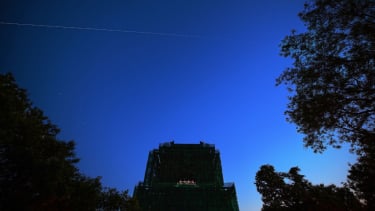- ANTARA/Dewa Ketut Sudiarta Wiguna
VIVA – As is known, on a clear sunny day, there is a blue sky. But is this the true color of the sky? Is it the only color of the sky? Well, the answers are a little complicated. But it involves the nature of light, atoms, molecules, and some quirky parts of Earth’s atmosphere and big lasers too.
The blue light that is usually seen is the Sun's rays that produce a broad spectrum of light, seen as white, but including all the colors of the Rainbow.
When Sunlight passes through the air, atoms, and molecules in the atmosphere, it scatters blue light in all directions, much more than red light. This is called Rayleigh scattering and results in a white Sun and blue sky on clear days.
As the Sunset, we can see this effect appear because the rays have to pass through more air. When the Sun is close to the horizon, almost all of the blue light is scattered (or absorbed by dust) so we end up with a red Sun with blue surrounding it.
Pemandangan langit di malam hari.
- Space.com
But, if all we see is the Sun's scattered rays, what is the true color of the sky? The answer might be seen at night. The night sky does look dark, but it's not completely black because of the stars. But the night sky itself glows. This is not light pollution, but the atmosphere shining naturally.
On a dark moonless night in the countryside, far from city lights, we can see the silhouettes of trees and hills in the sky. This light, called airglow, is produced by atoms and molecules in the atmosphere.
In visible light, oxygen produces green and red light, hydroxyl (OH) molecules produce red light, and sodium produces yellow light.
Nitrogen, while much more abundant in the air than sodium, does not contribute much to the airglow, according to the Science Alert website, Tuesday, January 3, 2023.
The different colors of airglow are the result of atoms and molecules releasing a certain amount of energy (quanta) in the form of light.
For example, at high altitudes where ultraviolet light can split oxygen (O2) molecules into pairs of oxygen atoms, and when these atoms then recombine into oxygen molecules, they produce a distinct green glow.





















